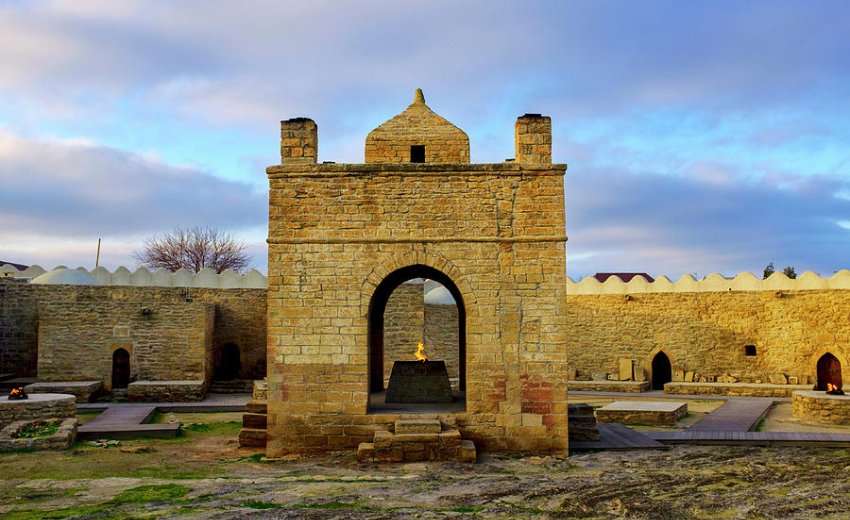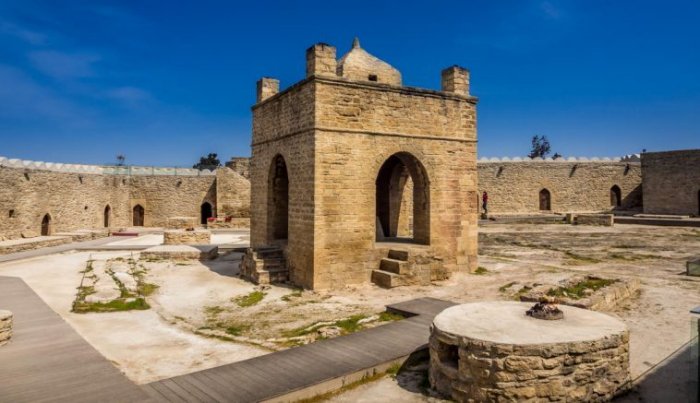In his article Guru Nanak's Travel an appraisal of Baku Visit, Gurvinder Singh Chohan has concluded that Guru Nanak did visit Baku because of the information in Memoirs of Zehir-ED-Din Mohammed Babur published by Oxford Press, 1921 and Baku- and eventful history and Zindgan-E-Shah Ismail_E aval (Persian) and inscription of commencing Verse of Guru Nanak found at two different places. According to him, the dates of these inscriptions are not available. Therefore, he had requested SGPC to have a research delegation sent to Baku for proper research. Unfortunately no such delegation of research scholars has been sent to Baku for locating contemporary evidence which could confirm that Guru Ji and Bhai Mardana had actually visited Baku and may have gone to Atishgah temple which is situated in Surakhani about 20 kms from Baku, the capital of Azerbaijan.
Recently, Dr. PS Walia of Mohali had gone to Baku for attending the conference of Dermatologist. During his visit he visited Atishgah and took some photographs highlighting the inscription in Punjabi language in Gurmukhi script. He also saw a Hindu temple where in Lord Shiva as Natraj is depicted and also saw the burning flame which depicts Goddess Jawalaji.
For doing research which could confirm the visit of Guru Nanak and Bhai Mardana to Atishgah following factual background would be relevant for the scholars.
Empire of Ismail-I
Shah Ismail-I was the founder of the Safavid Dynasty and ruled from 1501 to 1524. His empire consisted of present day Iran, Azerbaijan Republic, Armenia, most of Georgia, the North Caucasus, Iraq, Kuwait and Afghanistan, as well as parts of modern day Syria, Turkey, Pakistan, Uzbekistan and Turkmenistan. He was responsible for making Shia Islam as state religion. Ismail's greatest legacy was establishing an empire which lasted over 200 years is capital was Tabriz. Thus it is clear, that, during Guru Nanak's visit to Middle-East, Ismail-I was the Shah of Iran. According to Dr. Devinder Singh Chahal, Guru Nanak was in Middle-East for about 11 years (1511 and 1521). According to Dr. Dalvinder Singh Grewal, Guru Nanak had visited Iran thrice, first time while going from Karachi to Aden, he visited Bushahr Bander, second time when going from Madina to Baghdad, he visited Basra and third time after returning from Turkey and beyond when he visited Tabriz. If Guru Nanak had visited Tabriz which is capital of East Azerbaijan province he must have visited Atishgah because of it's importance to the travelers coming from Multan and Sindh.
Silk Road
The great Silk Roads bringing together two different Worlds-East and West, could not but leave a trace in the history of political, economic and cultural development of the countries through which it passed. Travelers, merchants and missionaries exchanged cultural, scientific, educational and spiritual values. Azerbaijan was on the path of the roads and made a significant contribution to the development of global transit network. The goods and products of Azerbaijani towns and settlements spread along with the Silk Roads with great success. Bilateral lands and sea routes linked Azerbaijan with China, Syria, India, Asia Minor, Iran, Egypt, Russia, the Arabian Peninsula, North Africa and Europe. The British used to lay their routes to India via Azerbaijan, Indian merchants traded in spices and cashmere fabrics with Baku and Shahmakhi. For this reason, actually one of the medieval caravan serias in Baku has the name of the Indian origin, "Multani". Baku used to serve as a transit point for goods passing from China and India through the Black sea through Constantinople. Thus considering the importance of Baku in Azerbaijan and location of Atishgah temple, the possibility of Guru Nanak visiting Azerbaijan during the reign of Ismail-I is great.
Importance of Atishgah of Baku
The Baku Atishgah, often called the "Fire Temple of Baku" is a castle like religious temple in Surakhani town, a suburb in Baku, Azerbaijan. Based on Persian inscription, the temple was used as a Hindu, Sikh and Zoroastrian place of worship. "Atish" is a Persian word for fire. The pentagonal complex, which has a courtyard surrounded by cells for monks and a tetra pillar-altar in the middle, was built during the 17th and 18th centuries. It was abandoned in the late 19th century, probably due to dwindling of the Indian population in the area. The natural eternal flame went out in 1969, after a century of exploitation of petroleum and gas in the area, but is now lit by gas piped from the nearby city. The Baku Atishgah was a pilgrimage and philosophical center of Zoroastrians from North-Western Indian sub-continent, who were involved in trade with Caspian area via the famous "Grand Trunk Road". The complex was turned into a museum in 1975. The annual number of visitors to the museum is 15000 plus.
Two inscriptions in Punjabi in Gurmukhi script
In the present form Atishgah Temple was built during 17th and 18th centuries. In the 2 inscription in Punjabi in Gurmukhi script after the "Mool-Mantra" or commencing verse, in first inscription in 5th,6th and 7th lines, it is mentioned, "Bava Jadusaha, whose pupil was Bava Bamkesaha, whose pupil was__ rasha built a sacred place" in the second inscription, in the 4th, 5th, 6th and 7th lines, it is mentioned "there was Bava (Ta) gadasa, Bamgewale resident, whose disciple was melarama further whose disciple was kartarama udasi". This sacred place called Jawalaji was built.
A research is required to be done for finding out the names of the persons who had got the inscriptions written probably in the beginning of 17th century. The concerned persons can be traders from Sindh or Multan who had faith in the teachings of Guru Nanak and were not satisfied with the worship of Jawalaji Goddess. Therefore research is required to be done for finding out who were the travelers from Sindh and Multan trading with Azerbaijan and beyond using Multani caravan srai in Baku. As large number of Indians were living around Atishgah temple or in Baku proper, the possibility of some evidence being available in Azerbaijani language or Persian language could not be ruled out. The Sikh disciples who were responsible for the two inscriptions in Punjabi in Gurmukhi script must have done so in early 17th century that is less than 100 years after Guru Nanak had left Baku for India. The question why Guru Nanak visited Azerbaijan becomes clear from the fact that Azerbaijan was part of the Iranian empire of Ismail-I and some parts of present day Pakistan were also part of his empire. In the Middle-East Guru Nanak had interacted with Suni population, Sufis and his visit to Iranian empire must have been to interact with Shia population. His focus on Atishgah shows that he wanted to tell the worshipers of fire that God is creator of Universe and his attributes mentioned in Mool-Mantra were required to be adopted by human beings so that they become truthful that is 'Sachiar'.
Request to SGPC, DGPC, Chief Khalsa Diwan etc.
For doing research and locating contemporary evidence about Guru Nanak's visit to Azerbaijan, resources are required and it is requested that brilliant research scholars may be identified and provided with funds so that they could find out contemporary evidence in Azerbaijan and Iran about Guru Ji's visit in the first early 16th century. This will be real celebration of 550th Parkash Utsav of Guru Nanak Dev Ji.

